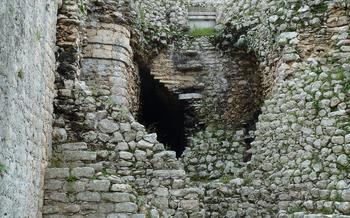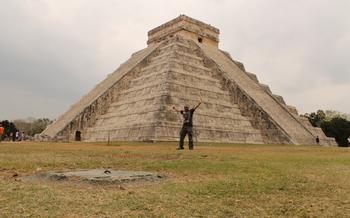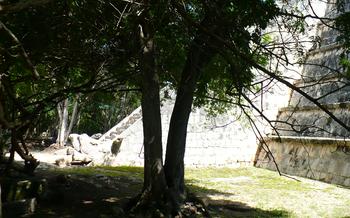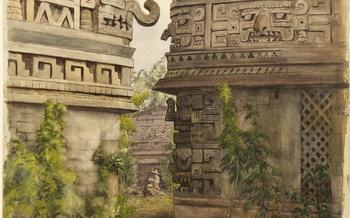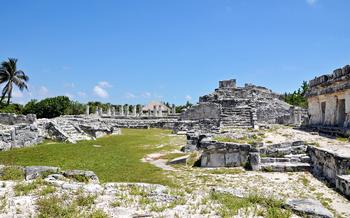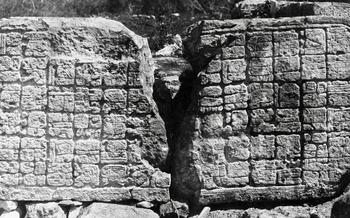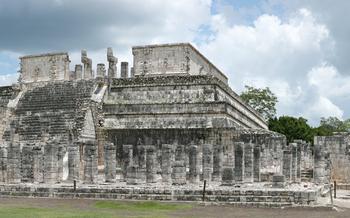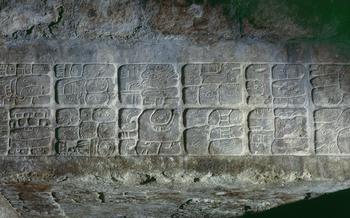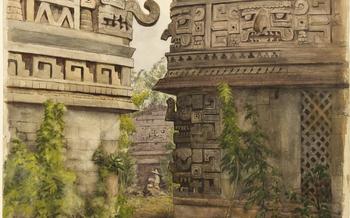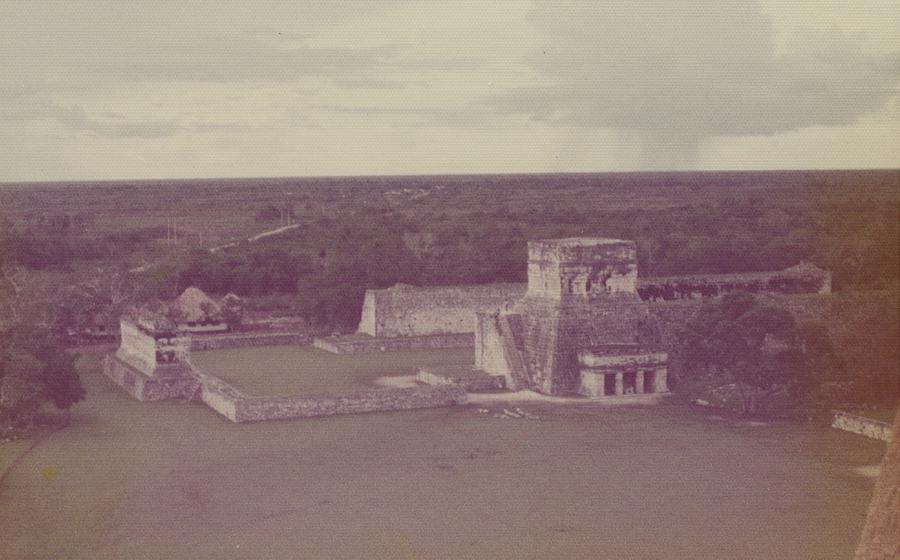
Las Monjas (The Nunnery)
- Las Monjas (The Nunnery)
- Location and Transportation
- Exploring the Complex
- Architectural Wonders
- Murals and Paintings
- The Red House
- The Nunnery Quadrangle
- The Temple of the Nuns
- Other Structures and Features
- The Sacred Cenote
- Visiting Tips
- Photography and Videography
- Local Experiences
- Insider Tip: Unraveling the Secrets of Las Monjas
Las Monjas (The Nunnery)
Las Monjas, also known as the Nunnery, is a captivating complex located within the ancient city of Chichen Itza, Mexico. This architectural marvel holds significant historical, religious, and cultural importance for the Maya civilization. Constructed around the 9th century AD, Las Monjas served as a sacred center dedicated to the goddess Ixchel, the deity associated with childbirth, healing, and water. The complex showcases an array of impressive structures, including the Temple of the Nuns, the Red House, and the Nunnery Quadrangle, each adorned with intricate murals and carvings that provide a glimpse into the rich artistic and spiritual traditions of the Maya people.
Location and Transportation
Chichen Itza is situated in the Yucatan Peninsula of Mexico, approximately 125 miles (200 kilometers) east of Cancun and 75 miles (120 kilometers) southwest of Merida. The journey from Cancun takes around 5 hours by car, while from Merida, it takes approximately 5 hours.
To reach Chichen Itza, you can either drive or take a guided tour from Cancun or Merida. Several transportation options are available, including rental cars, buses, and private tours. Guided tours often include round-trip transportation, entrance fees, and the services of a knowledgeable guide.
Once you arrive at Chichen Itza, there is ample parking available for both cars and tour buses. The parking area is located just a short walk from the main entrance to the site.
Exploring the Complex
The complex of Las Monjas is a testament to the architectural prowess and religious beliefs of the ancient Mayans. Its name, meaning "The Nunnery," was given by Spanish explorers who mistakenly believed it to be a convent. The complex is comprised of several structures arranged around a central courtyard, each serving a specific purpose within the religious and social life of the Maya.
Notable features of the complex include the Red House, a well-preserved structure adorned with intricate carvings and brightly colored murals. The Nunnery Quadrangle, the central courtyard, is surrounded by various buildings, including the Temple of the Nuns, the most significant structure within the complex.
To fully appreciate the significance of Las Monjas, it's recommended to follow a specific route. Begin by exploring the Red House, marveling at its architectural details and vibrant murals. From there, proceed to the Nunnery Quadrangle, where you can admire the surrounding structures and their intricate iconography. Finally, make your way to the Temple of the Nuns, where you can learn about its religious significance and the rituals performed within its sacred walls.
Audio guides and self-guided tours are available for those who wish to delve deeper into the history and symbolism of Las Monjas. These tours provide insightful commentary, helping visitors understand the complex's importance and its role in Mayan civilization.
Architectural Wonders
Las Monjas stands out for its unique architectural style, showcasing the advanced construction techniques and materials mastered by the Maya. The complex was built using limestone blocks, intricately carved and assembled with precision. The walls feature distinctive decorative elements, such as moldings, friezes, and niches, which add depth and texture to the structures.
The symbolism and iconography depicted in the architecture of Las Monjas provide valuable insights into Mayan beliefs and mythology. The complex is adorned with intricate carvings and sculptures representing deities, mythical creatures, and scenes from daily life. These representations offer a glimpse into the rich cultural and religious heritage of the Maya.
The architectural style of Las Monjas influenced subsequent Mayan architecture, leaving a lasting legacy on the cultural landscape of the region. Its unique features and design principles were adopted and adapted by other Maya cities, contributing to the development of a distinctive and recognizable Maya architectural style.
Murals and Paintings
The Nunnery is adorned with a remarkable collection of murals and paintings, which offer a vibrant glimpse into the artistic prowess and religious beliefs of the ancient Mayans. These artworks are characterized by their intricate designs, vibrant colors, and detailed depictions of Mayan deities, mythological scenes, and everyday life.
The murals cover a wide range of subjects, from depictions of the gods to scenes of warfare, agriculture, and daily life. The most striking feature of these murals is their use of color. The Mayans used a variety of natural pigments, including red, blue, green, and yellow, to create vivid and eye-catching images.
The techniques used to create these murals were also quite sophisticated. The Mayans used a combination of fresco and tempera painting, which involved applying paint to wet or dry plaster. This technique allowed them to achieve a high level of detail and realism in their artwork.
The murals and paintings of the Nunnery are not only beautiful works of art but also valuable sources of information about Mayan culture and religion. They provide insights into the beliefs and practices of the Mayans and offer a glimpse into their rich and vibrant world.
The Red House
Amidst the ancient structures of Las Monjas, the Red House stands out as a captivating enigma. Its vibrant red exterior, a striking contrast to the surrounding beige tones, immediately draws the eye. The Red House, also known as "La Casa Colorada," served as a significant ceremonial and administrative building within the Nunnery complex.
Archaeological evidence suggests that the Red House was likely used for various religious rituals and ceremonies. Its interior walls are adorned with intricate murals depicting Mayan deities, mythological scenes, and historical events. These murals provide valuable insights into the beliefs and practices of the ancient Maya.
The construction and design of the Red House showcase the advanced architectural skills of the Maya. The building features a unique corbeled arch, a construction technique that allows for the creation of large, open spaces without the use of supporting columns. This architectural innovation demonstrates the Maya's mastery of engineering and their ability to construct impressive structures without the use of modern tools or materials.
The exact purpose of the Red House remains a subject of debate among scholars. Some believe it served as a temple dedicated to a specific deity, while others propose it was used as a meeting place for religious or administrative gatherings. Regardless of its precise function, the Red House stands as a testament to the cultural and religious significance of Las Monjas and offers a glimpse into the complex and fascinating world of the ancient Maya.
The Nunnery Quadrangle
The Nunnery Quadrangle, also known as the Great Quadrangle, forms the heart of the Las Monjas complex. This central courtyard is enclosed by a series of low-lying structures, each serving a specific function within the complex. The quadrangle served as a versatile space for various religious ceremonies, rituals, and community gatherings.
The surrounding structures feature intricate carvings, decorative elements, and remnants of murals, providing a glimpse into the artistry and symbolism of the Maya. Altars, stelae, and other ceremonial elements dot the quadrangle, offering insights into the rituals performed here.
One of the most significant structures within the quadrangle is the Temple of the Nuns, which stands out with its imposing presence. The temple's design and iconography suggest that it was dedicated to the goddess Ixchel, the Mayan goddess of childbirth, healing, and water.
Exploring the Nunnery Quadrangle is a journey into the religious and social life of the ancient Maya. Each structure and feature within the quadrangle contributes to the understanding of their beliefs, practices, and the interconnectedness of their community.
The Temple of the Nuns
The most prominent structure within the Las Monjas complex is undoubtedly the Temple of the Nuns. This edifice stands out not only for its architectural grandeur but also for its profound religious significance. Built on a raised platform, the temple features a unique corbelled arch that leads to a small interior chamber. The walls of this chamber are adorned with intricate carvings and bas-reliefs depicting various Mayan deities, including the rain god Chaac and the maize god Yum Kaax. These elaborate decorations suggest that the temple was a sacred space dedicated to important rituals and ceremonies. The Temple of the Nuns played a crucial role in Mayan religious life, serving as a place of worship, prayer, and offerings to the gods. Its architectural design and iconography provide valuable insights into the spiritual beliefs and practices of the ancient Maya.
Other Structures and Features
Beyond the main buildings and courtyards, the Nunnery complex encompasses a variety of additional structures and features that contribute to its significance and complexity. These include smaller temples, altars, stelae, and other ceremonial elements, each with its own unique function and symbolism.
One notable structure is the Temple of the Masks, located on the eastern side of the quadrangle. This temple is adorned with intricate carvings depicting various deities and mythical figures, including the rain god Chaac and the maize god Yum Kaax. The symbolism and iconography found on these carvings provide valuable insights into Mayan religious beliefs and practices.
Another important feature of the complex is the Great Platform, located on the southern side. This massive platform served as a base for several smaller structures, including the Temple of the Warriors and the Temple of the Eagles. The Great Platform demonstrates the skill and engineering prowess of the Maya, who were able to construct such large and complex structures without the use of modern tools or machinery.
Throughout the Nunnery complex, visitors can find various altars and stelae, which were used for religious rituals and ceremonies. These monuments often feature inscriptions and carvings that provide valuable historical information and insights into the lives of the Maya who once inhabited this site.
The interconnections between the different parts of the Nunnery complex are also significant. The placement and alignment of the buildings and courtyards create a sense of harmony and balance, reflecting the Maya's deep understanding of astronomy and mathematics. The complex's design allowed for the observation of celestial events and the performance of rituals associated with the cycles of the sun, moon, and stars.
Exploring these additional structures and features provides a deeper understanding of the complexity and significance of the Nunnery complex. Visitors can gain insights into the religious beliefs, rituals, and daily lives of the ancient Maya who constructed and inhabited this remarkable site.
The Sacred Cenote
The Sacred Cenote, a natural well located just a short distance from the Nunnery complex, holds immense religious and mythological significance for the Mayans. It was believed to be a gateway to the underworld, Xibalba, and a place of communication with the gods. The Mayans performed various rituals and ceremonies at the cenote, including offerings, sacrifices, and pilgrimages. The cenote's waters were considered sacred, and it was believed that throwing offerings into the cenote would bring good fortune and favor from the gods.
The Sacred Cenote is a testament to the importance of water in Mayan culture. Water was essential for agriculture, sustenance, and religious rituals. The Mayans believed that water was a gift from the gods and that it had the power to heal and purify. The cenote, with its crystal-clear waters and mystical aura, was a place where the Mayans could connect with the divine and seek blessings for their lives and their community.
Visiting Tips
Visiting Chichen Itza and Las Monjas requires careful planning to make the most of your experience. Consider the following tips to ensure a smooth and enjoyable visit:
-
Best time to visit: Aim for the shoulder seasons (April-May and September-October) to avoid the peak tourist crowds of winter. The weather during these months is still pleasant, with fewer visitors competing for space and attention.
-
Duration of visit: Allocate at least two to three hours to explore the entire complex. This will give you ample time to wander through the various structures, admire the murals, and soak in the history of Las Monjas.
-
Suggested itinerary: Start your visit early in the morning to beat the heat and crowds. Begin with Las Monjas, then proceed to the main pyramid, El Castillo, and explore the other surrounding structures.
-
Dress code: Respect the cultural significance of the site by dressing appropriately. Avoid revealing or overly casual clothing, and opt for comfortable footwear suitable for walking on uneven surfaces.
-
Respecting the site: Remember that Las Monjas is an ancient religious site, so be mindful of your behavior. Refrain from touching or climbing on the structures, and avoid loud noises that may disturb other visitors.
Photography and Videography
Capturing the Essence of Las Monjas through Visual Storytelling
Las Monjas, with its captivating beauty and rich history, presents a paradise for photography and videography enthusiasts. While capturing the essence of this ancient nunnery, it's essential to adhere to the rules and regulations set forth by the authorities. These guidelines help preserve the integrity of the site and ensure a respectful experience for all visitors.
When venturing into Las Monjas with your camera or video equipment, be prepared to be mesmerized by the intricate details and vibrant colors that adorn every corner. The architectural wonders, murals, and sculptures provide endless opportunities for captivating shots. To make the most of your visual storytelling journey, consider the following tips:
-
Choose the Right Equipment: A wide-angle lens is your best friend for capturing the grandeur of the complex. A tripod will ensure stability for crisp and clear shots. For videographers, a steadycam or gimbal can help create smooth and cinematic footage.
-
Embrace Natural Lighting: The golden hours of sunrise and sunset bathe Las Monjas in a magical glow, making them ideal times for photography. Harsh midday sunlight can create harsh shadows, so consider using a diffuser or reflector to soften the light.
-
Focus on Details: The intricate carvings, vibrant murals, and symbolic motifs that adorn the complex are waiting to be discovered through your lens. Zoom in to capture the delicate artistry that brings Las Monjas to life.
-
Compose Your Shots: Take a step back and observe the scene before composing your shot. Consider the elements of composition like leading lines, symmetry, and depth of field to create visually appealing images.
-
Share Your Experiences: Once you've captured the beauty of Las Monjas, share your experiences with the world through social media. Tag your photos and videos with relevant hashtags to connect with fellow travelers and inspire others to explore this incredible site.
Local Experiences
Beyond exploring the ancient ruins, Chichen Itza offers a wealth of opportunities for cultural immersion. Engage with local vendors and artisans who display their handcrafted goods, from intricate textiles to colorful pottery. Discover the flavors of traditional Mayan cuisine by savoring regional delicacies such as cochinita pibil, a slow-cooked pork dish infused with achiote.
Venture beyond the main complex to explore the surrounding area, dotted with cenotes, haciendas, and charming Mayan villages. Immerse yourself in the local culture by participating in traditional ceremonies, markets, or cooking classes. These experiences provide a glimpse into the vibrant heritage and daily life of the Mayan people.
Insider Tip: Unraveling the Secrets of Las Monjas
Beyond the bustling crowds and well-trodden paths of the Chichen Itza complex, there lies a hidden gem waiting to be discovered within the confines of Las Monjas. As you wander through the intricate passageways and courtyards, keep an eye out for a secluded corner adorned with intricate carvings that depict scenes from Mayan mythology. This hidden alcove, often overlooked by visitors, offers a glimpse into the private world of the ancient Mayan nuns who once called this place home.
For an even more immersive experience, venture into Las Monjas early in the morning or late in the afternoon, when the site is bathed in a warm, golden light and the air is still and serene. As you stand in the tranquility of the complex, let your imagination transport you back in time, envisioning the rituals and ceremonies that once took place here. Embrace the tranquility and solitude of this hidden sanctuary, and you'll be rewarded with an unforgettable encounter with the spirit of ancient Maya.
